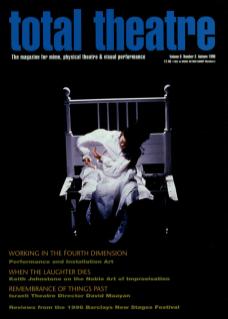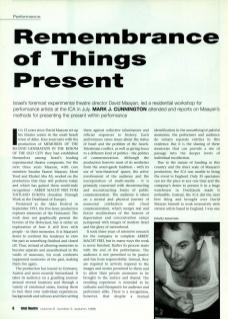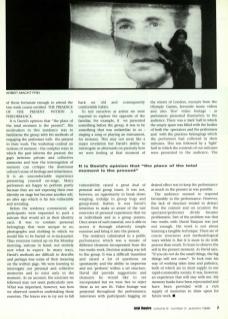It is twelve years since David Maayan set up his theatre centre in the small Israeli town of Akko. Four years later with the production of Memories of the Second Generation in the Bosom of the Old City they had established themselves among Israel's leading experimental theatre companies. For the next three years Maayan, with core members Smadar Yaaron Maayan, Moni Yosef and Khaled Abu Ali, worked on the production that they still perform today and which has gained them worldwide recognition – Arbeit Macht Frei Vom Toitland Europa (Freedom Through Work in the Deathland of Europe).
Premiered at the Akko Festival in September 1991, the five-hour production explores memories of the Holocaust. The work does not graphically present the horrors of the Holocaust, but is rather an exploration of how it still lives with people – in their memories. It is Maayan's desire to confront the tendency to view the past as something finished and closed off. Thus, instead of allowing memories to become separate and anaesthetised in the vaults of museums, his work confronts suppressed memories of the past, making them live again.
The production has toured to Germany, Austria and most recently Switzerland. It takes its audience on a gruelling journey around several locations and through a variety of emotional states, forcing them to face their own individual experiences, backgrounds and cultures and then setting them against collective inheritances and official responses to history. Each performance raises issues about the status of Israel and the problem of the Israeli-Palestinian conflict, as well as giving focus to a different kind of politics – the politics of commemoration. Although the production borrows most of its aesthetics from the avant-garde tradition – with its use of 'non-theatrical' spaces, the active involvement of the audience and the incorporation of multimedia – it is primarily concerned with deconstructing and reconstructing forms of public commemoration. The audience is taken on a mental and physical journey of memorial celebration and ritual commemoration, which merges real and fictive recollections of the horrors of deportation and concentration camps juxtaposed with images of modern Israel and the glory of nationhood.
It took three years of intensive research for the company to complete Arbeit Macht Frei, but in many ways the work is never finished. Rather its process starts with the end of the performance. The audience is not permitted to be passive and free from responsibility. Instead, they are required to actively respond to the images and stories presented to them and to allow their private memories to be brought to the surface and shared. The resulting experience is intended to be cathartic and therapeutic for audience and performers alike. There is a recognition, however, that despite a mutual identification in the unearthing of painful memories, the performers and audience do remain separate entities in this existence. But it is the sharing of these memories that can provide a rite of passage into the deeper levels of individual recollection.
Due to the nature of funding in this country and the sheer scale of Maayan's production, the ICA was unable to bring the event to England. Only 35 spectators can see the piece at any one time and the company's desire to present it in a huge warehouse in Docklands made it unfeasible. Instead, the ICA did the next best thing and brought over David Maayan himself to work intensively with sixteen artists based in England. I was one of those fortunate enough to attend the two-week course entitled ‘The Presence of the Present within a Performance’.
It is David's opinion that ‘the place of the total moment is the present’. His motivation in this residency was to familiarise the group with his methods of engaging the performer with the present in their work. The workshop centred on notions of memory – the complex ways in which the past informs the present; the gaps between private and collective memories and how the interrogation of memory can critique the dominant culture's sense of heritage and inheritance. It is an uncomfortable experience presenting yourself on-stage. Many performers are happy to perform partly because they are not exposing their own identity on stage but become another self, an alter ego which is far less vulnerable and revealing.
Before the residency commenced, all participants were requested to pack a suitcase that would act as their identity card. It was to contain personal belongings that were unique to us; photographs and clothing in which we would like to be buried or reincarnated. Thus everyone turned up on the Monday morning, suitcase in hand, not entirely sure what to expect. In many ways, David's methods are difficult to describe and perhaps lose some of their meaning on the written page. We were learning to interrogate our personal and collective memories and to exist only in the moment. As an account, the exercises we followed may not seem particularly new. What was important, however, was how we observed ourselves undertaking those exercises. The lesson was to try not to fall back on old and consequently comfortable habits.
To test ourselves as artists we were required to explore the opposite of the familiar. For example, if we presented something before the group, it was to be something that was unfamiliar to us – singing a song or playing an instrument, for instance. This may not seem like a major revelation but David's ability to interrogate us afterwards on precisely how we were feeling at that moment of vulnerability raised a great deal of personal and group issues. It was not, however, an opportunity to break down weeping, indulge in group hugs and group-bond. Rather, it was David's intention to make us aware of the vast reservoirs of personal experiences that we as individuals and as a group possess. Once aware of such material, one is able to access it through relatively simple exercises and bring it into the present.
The residency culminated in a public performance which was a mosaic of different elements incorporated from the two weeks’ work. Decision making was left to the group. It was a difficult transition and raised a lot of questions on spontaneity and the ability to improvise and not 'perform' within a set structure. David did provide suggestions and elements he would like to see incorporated but we were free to reject these as we saw fit. Video footage was projected throughout the performance – interviews with participants begging on the streets of London, excerpts from the Olympic Games, favourite music videos and also 'live' video footage – as performers presented themselves to the audience. There was a 'dark' half in which the empty space was filled with the bodies of both the spectators and the performers and with the precious belongings which the performers had collected in their suitcases. This was followed by a 'light' half in which the contents of our suitcases were presented to the audience. The desired effect was to keep the performance as much in the present as was possible.
The audience seemed to respond favourably to the performance. However, the lack of structure tended to detract from the content and on occasion the spectator/performer divide became problematic. Part of the problem was that two weeks with David Maayan was just not enough. His work is not about learning a tangible technique. There are of course structures and methodological ways within it. But it is more to do with process than result. To learn to observe the self in the present moment. As David says, ‘If you do not do the small things, the big things will not come.’ To lock into his way of working takes time and patience, both of which are in short supply in our rapid-commodity society. It was, however, an experience that will stay with me. My memory banks have been rejuvenated and have been provided with a rich supply of memories to draw upon for future work.


